Exersaucer Age Ranges: The Right Ages to Start & Stop
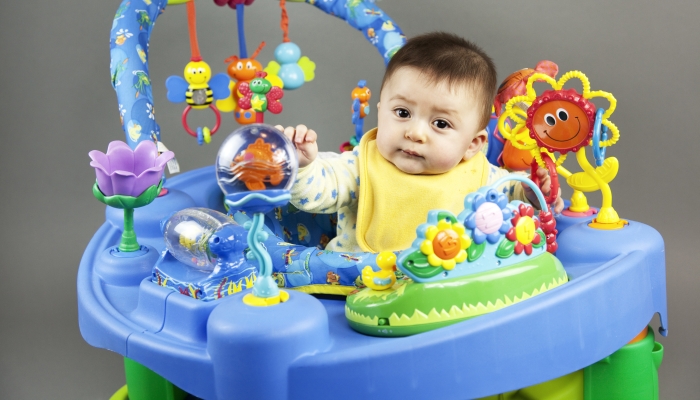
- Exersaucers are safer to use than baby walkers.
- Only use an exersaucer if your baby has reached the recommended developmental milestones.
- Always follow the exersaucer age and weight limit regulations.
- Placing your baby in their exersaucer near swimming pools, kitchen areas, or stairs is dangerous.
- Exersaucers can hinder gross and motor development if misused.
Being a new parent is overwhelming! A great deal of information is available to help you ace your parenting journey, but most of it leaves you more confused than before you started reading. I still remember the heated debates around exersaucers and baby walkers when I was pregnant with our first.
Listening to professionals and following their guidelines is your best bet. They agree that babies who move freely and develop naturally have better body awareness. Containment devices don’t encourage motor development.
Still, using an exersaucer doesn’t make you a bad parent—it has its place. If you follow exersaucer age and usage guidelines as stated by professionals, your baby will be okay.
What Is An Exersaucer?
Exersaucers are the safer version of baby walkers. Instead of wheels, this play center has a saucer-shaped bottom to keep it immobile. Your little one can spend time bouncing, playing, and interacting in it.
How Safe Are Exersaucers?
Using an exersaucer is safe if you follow the proper guidelines. In 2018, the American Academy of Pediatrics (AAP) reported that over a thousand children need hospital treatment due to injuries from their walkers in severe cases yearly. They called for a ban on these, but exersaucers were excluded.
You can safely use an exersaucer if you keep these things in mind:
- Only use an exersaucer if your baby is alert. Sleepy kids could flop around and injure themselves.
- Always supervise your little one while they’re in the exersaucer.
- Don’t keep your baby in their exersaucer for more than 15 minutes, and limit use to once a day.
- Don’t place the exersaucer near stairs, things your baby could easily reach and pull onto themselves, or areas where they could get injured, like a hot oven.
- Use an exersaucer that’s suited for your baby. Pay attention to manufacturer weight and age limit guidelines.
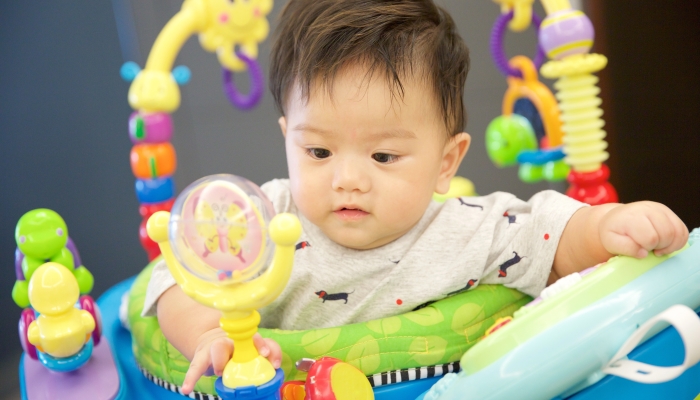
What Age Can a Baby Start Using an Exersaucer?
The recommended age for using an exersaucer is 6 or 7 months. However, your baby’s development is a better indicator. Placing your little one in an exersaucer before they’re ready carries risks. Health experts mention decreased balance and poor posture when speaking of these.
Occupational therapist Lauren Hershfield advises parents to wait until their baby can sit without using their arms for balance. She says this milestone will help prevent poor posture while in the exersaucer.
Also, keep in mind that:
- Your baby’s feet should touch the floor while using their exersaucer. This will help them develop body awareness.
- Your baby should pull themselves up and stand with or without support. This milestone will prevent poor habits and decreased balance.
- Your baby should be developmentally ready for all the stimulation exersaucers provide. Long periods of sensory overload could lead to a spike in stress hormones.
What Are the Pros and Cons of Exersaucers
Exersaucers aren’t all bad. Professionals agree that limited use is okay. The decision is ultimately yours, but here are the pros and cons to consider!
The Advantages of Using an Exersaucers
Exersaucers Are Safer Than A Baby Walker
If you considered using a baby walker, opt for an exersaucer instead. Putting babies in exersaucers carries fewer risks when used safely. Remember to wait until your child reaches the recommended developmental stage. Place them in their exersaucer for at most 15 minutes per day.
Exersaucers Provide a Change of Scenery
Exersaucers have various plastic toys attached. Your baby can practice gross and fine motor skills depending on which accessories their play station has. If you don’t remove their activity tray for floor play, these toys will be something they look forward to each day. While standing in the exersaucer, your little one also has a different view of their surroundings.
Exersaucers Can Entertain Your Baby
You should never leave your baby unattended in their exersaucer. If you want a much-needed break, you can watch them play while enjoying a cup of tea. Exersaucers act as an activity station your little one can use for short periods. You shouldn’t use it as a babysitter, so if you’re doing chores, always keep it close by.
The Disadvantages of Exersaucers
Exersaucers Place Babies in Weight-Bearing Positions
Parents who follow manufacturer age recommendations tend to place their babies in exersaucers before their muscles are ready. The position your baby’s body is in when using an exersaucer places weight on their pelvis and trunk.
Extended periods in this pose can lead to musculoskeletal issues like toe-walking, knee pain, and hip weakness.
Exersaucers Can Sabotage Your Baby’s Development Process
After babies learn to sit independently, you should encourage crawling. Some children go from sitting to walking, but motivating your little one to explore this form of movement is vital for developing their large muscles. If you put your baby in an exersaucer before they can crawl, they’ll likely prefer a standing position.
Contrary to popular belief, exersaucers don’t help children walk sooner. It only hinders their normal developmental process by eliminating the need to get into a different position than sitting alone. This can negatively impact their balance, posture, and overall muscle development.
Exersaucers Limit Creativity and Movement
Putting your baby in an exersaucer for extended periods limits opportunities for cognitive development. If your baby can push buttons and play with toys within their reach, they’ll have no need to explore, learn new skills, or use their imagination.
Exersaucers limit movement too. Even if your little one wants to venture, they’ll be stuck in their activity center. Extended time in one position can cause bad posture and hinder hip development. Babies should move around freely to strengthen muscles and develop motor skills.
Exersaucers Can Overstimulate Your Baby
Exersaucers mainly sell for their interesting attached toys. Younger babies still need to develop their sensory skills, and all the lights, sounds, and textures can overstimulate them. If your baby feels overwhelmed, you should reduce the noise and activity around them.
Exersaucers Increase Your Baby’s Risk of Developing Container Baby Syndrome
Container baby syndrome appears in babies who spend most of their day in containment devices like exersaucers, according to Dana Thomsen, PT, DPT, PCS. Your baby needs to move around for proper development.
Babies who have limited movement opportunities can develop flat heads, tightness in their necks, and delayed muscle growth. If this happens, your little one will have trouble holding things, lifting their hands or head, and crawling.
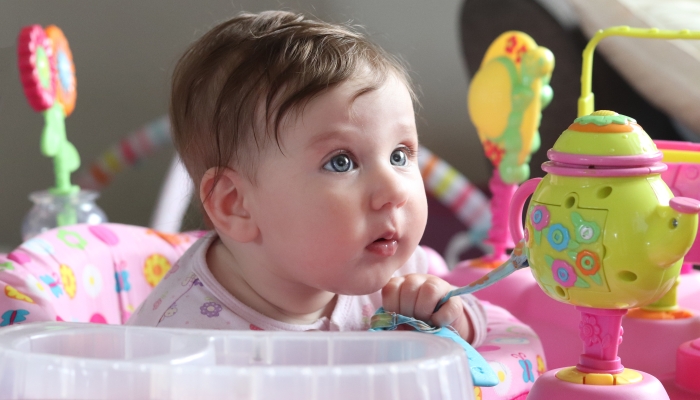
When It’s Time to Put Away the Exersaucer
If you heard other mothers say that exersaucers are bad for babies, they weren’t wrong. You could return your new exersaucer to the store if you already bought one and decided against it. However, if you choose to use the exersaucer with your little one, pack it away after your baby’s been in it for 10-15 minutes.
Another reason to ditch this activity center altogether is age and weight limits. If you use your exersaucer as recommended, your child will quickly outgrow it. You shouldn’t continue using the exersaucer to get more bang for your buck. This is risky, and your baby could get injured.
When the time in your parenting journey comes when using devices to keep your little one entertained is no longer needed, pack the exersaucer away! If your baby can stay safe while you open the oven or clean the pool without being contained, it’ll be much better for them to move freely.
Tips on Using an Exersaucer
Not everything about an exersaucer is negative. Whether you got one as a gift or decided to use it despite the controversy, follow these tips to keep your little one safe and ensure you don’t delay their cognitive or motor development:
- Limit Use. Besides traveling, babies shouldn’t spend more than 15-20 minutes in a containment device daily. Limit how much you place your child in their exersaucer. A good guideline is ensuring they spend 90% of their playtime moving freely.
- Check Their Feet. Your baby should stand flat-footed in their exersaucer. If only their toes touch the ground, your baby isn’t tall enough to use an exersaucer yet. Dangling can put extra pressure on their hips and cause joint pain.
- Keep Close. Babies can’t walk around in their exersaucer, but you still need to keep them close. Accidents happen in the blink of an eye. You’ll want to be nearby if it does. Your baby could fall forward and bump their head on the attached toys or get injured if the exersaucer seat rips. A quick response is crucial.
- Remove The Activity Tray. Most exersaucers have removable toys. Remove the activity tray if your baby reaches their time limit for the day but still wants to play. They can continue interacting with the toys on the floor or at a table.
- Alternate Devices. You can alternate between baby jumpers, exersaucers, playpens, and other containment devices that are a safer alternative to baby walkers. If you buy a good quality baby jumper, your little one will enjoy movement and play. Likewise, a playpen allows for more activity than exersaucers. Alternating your baby’s activity center will reduce motor delays and improve cognitive development.
Ultimately, the decision is yours. Exersaucers aren’t a necessity but can act as a helping hand. If your baby has head control, core strength and starts pulling themselves up to stand, using one every now and then won’t harm their development.
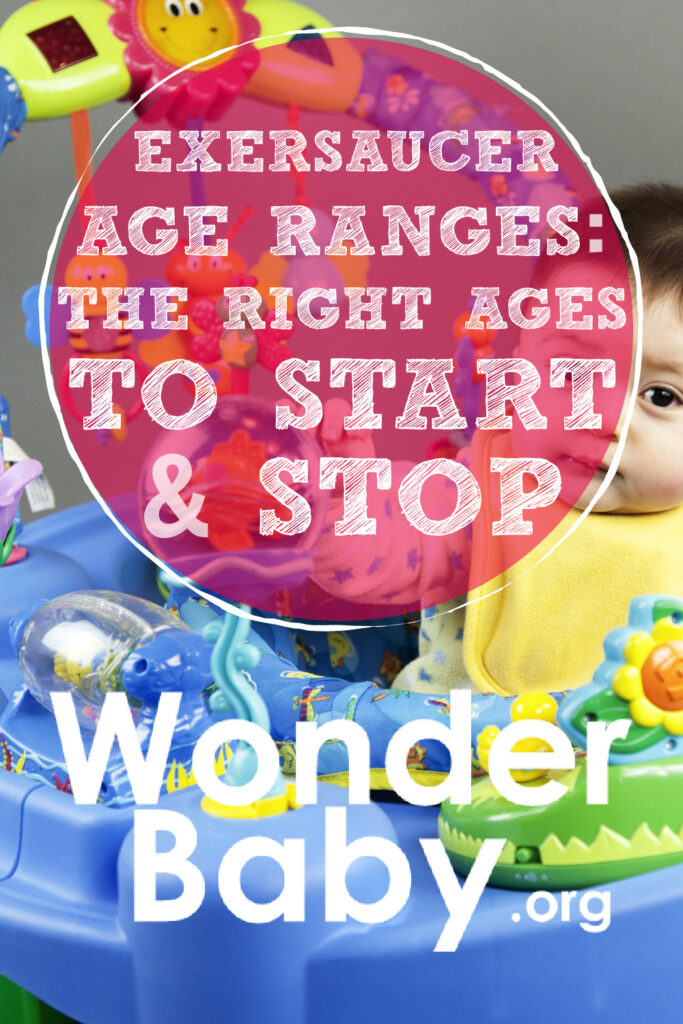
Related Posts
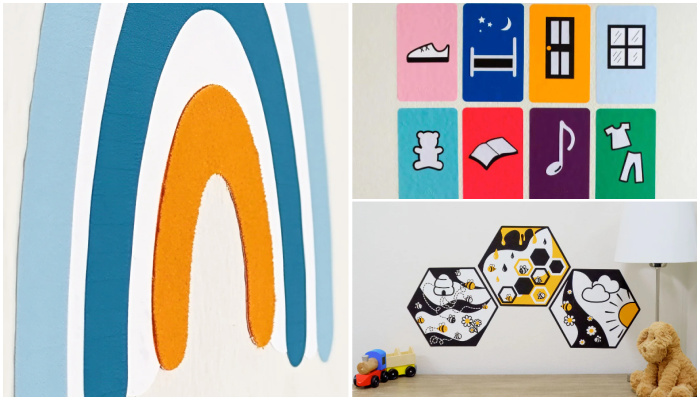
Parenting
Sensory Wall Art: 5 Tips to Create a Room Your Blind or Low-Vision Child Will Love
Even if your child can’t see their surroundings, personalizing and decorating their room with thoughtful, sensory-friendly design can make a big difference in their confidence, independence, and joy.
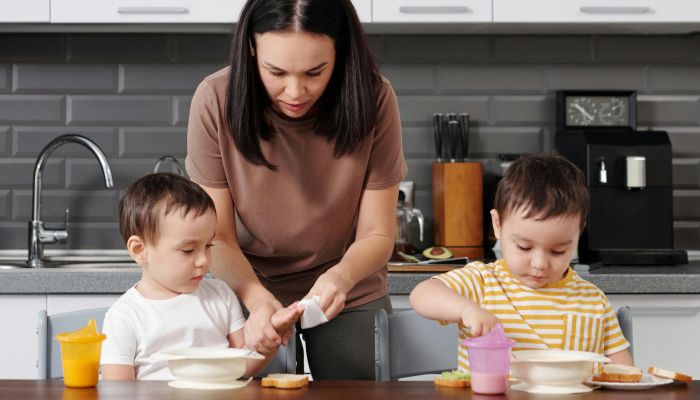
Parenting
4 Tips to Manage Twins Alone as a Single Parent
Taking care of twins alone as a single parent can feel overwhelming. Learn practical ways to help lighten the load.

Parenting
How to Manage Twin Escalation Syndrome
Discover effective strategies for managing twin escalation syndrome, including promoting individuality and fostering positive interactions.